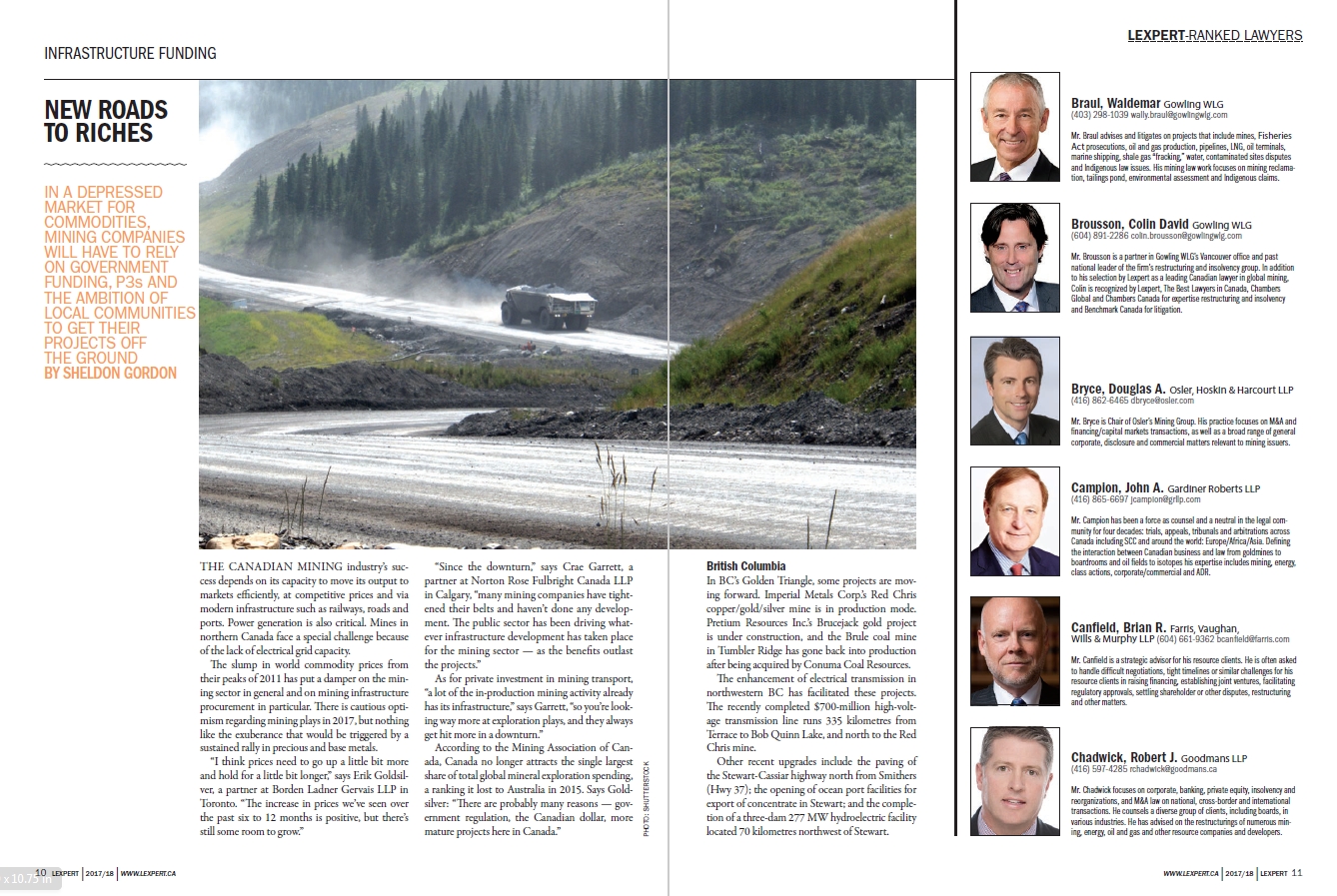New Roads to Riches
posted on
Sep 22, 2017 10:43AM

NI 43-101 Update (September 2012): 11.1 Mt @ 1.68% Ni, 0.87% Cu, 0.89 gpt Pt and 3.09 gpt Pd and 0.18 gpt Au (Proven & Probable Reserves) / 8.9 Mt @ 1.10% Ni, 1.14% Cu, 1.16 gpt Pt and 3.49 gpt Pd and 0.30 gpt Au (Inferred Resource)

http://www.lexpert.ca/article/infrastructure-funding-new-roads-to-riches/?p=&sitecode=lex
 THE CANADIAN MINING INDUSTRY’S success depends on its capacity to move its output to markets efficiently, at competitive prices and via modern infrastructure such as railways, roads and ports. Power generation is also critical. Mines in northern Canada face a special challenge because of the lack of electrical grid capacity.
THE CANADIAN MINING INDUSTRY’S success depends on its capacity to move its output to markets efficiently, at competitive prices and via modern infrastructure such as railways, roads and ports. Power generation is also critical. Mines in northern Canada face a special challenge because of the lack of electrical grid capacity.
The slump in world commodity prices from their peaks of 2011 has put a damper on the mining sector in general and on mining infrastructure procurement in particular. There is cautious optimism regarding mining plays in 2017, but nothing like the exuberance that would be triggered by a sustained rally in precious and base metals.
“I think prices need to go up a little bit more and hold for a little bit longer,” says Erik Goldsilver, a partner at Borden Ladner Gervais LLP in Toronto. “The increase in prices we’ve seen over the past six to 12 months is positive, but there’s still some room to grow.”
“Since the downturn,” says Crae Garrett, a partner at Norton Rose Fulbright Canada LLP in Calgary, “many mining companies have tightened their belts and haven’t done any development. The public sector has been driving whatever infrastructure development has taken place for the mining sector — as the benefits outlast the projects.”
As for private investment in mining transport, “a lot of the in-production mining activity already has its infrastructure,” says Garrett, “so you’re looking way more at exploration plays, and they always get hit more in a downturn.”
According to the Mining Association of Canada, Canada no longer attracts the single largest share of total global mineral exploration spending, a ranking it lost to Australia in 2015. Says Goldsilver: “There are probably many reasons — government regulation, the Canadian dollar, more mature projects here in Canada.
ONTARIO
Ten years after massive deposits of chromite, nickel and copper were discovered in Ontario’s James Bay lowlands, the Ring of Fire development is stalled due to low commodity prices, the absence of agreement with Aboriginal communities in the area and a lack of transportation infrastructure.
“For projects like that, which require not only mining development but all of the infrastructure, that takes a much stronger rally in commodity prices than to develop something that is in an existing infrastructure area,” says Melanie Shishler, a partner at Davies Ward Phillips & Vineberg LLP. “Ultimately, [decisions on infrastructure] will be political as well as financial. You have to work through the political channel to make sure you get the permits you need to go one way or another.”
Toronto-based Noront Resources Ltd., the largest company that remains in the Ring of Fire, favours an all-weather, east-west road to be built over the muskeg to the mine site. Although Ontario has committed $1 billion to fund transportation infrastructure in the region, little work has been done to prepare for a road. No route has been selected, and no agreements put in place on who would fund it or who would own or maintain it.
Meanwhile, Toronto-based KWG Resources Inc. has proposed building a rail line to the mineral deposits using engineering and long-term financing from China. If approved, the $4-billion rail line would mark the first time that a Chinese rail company has played a major role in rail construction in Canada. (China is the world’s largest importer of chromium, used in stainless steel.)
The proposed north-south rail line, about 340 kilometres, would connect the Ring of Fire to an existing CN Rail line near Nakina, Ontario. Chinese engineers from a subsidiary of the state-owned enterprise China Railway Construction Corp. visited the region in April of last year and prepared a feasibility study for Chinese financial institutions.
Noront has criticized KWG’s proposal for a north-south rail line, arguing that an east-west road is more affordable and would allow the region to be developed in stages, while also connecting more First Nations communities to the south.
“From the company’s perspective, they want someone to build the roads or the railway for them,” says Goldsilver. “At the end of the day, it’s probably going to have to be some sort of public-private partnership, because the majority of that road is going to be used by the mining companies.”